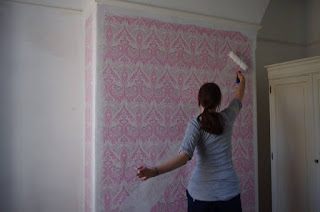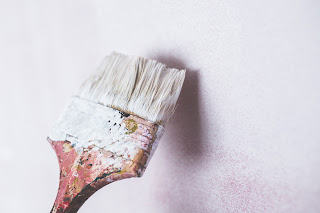All These Interiors Ultimate Guide:
Picking the Perfect Paint Finish
For a novice, the world of paint can be a confusing place, finding the right advice can be a minefield with either hardly any information to tediously technical essays that don't answer the question what paint finish can I use in a hallway. If you have you ever asked yourself what is the difference between normal and gloss paint, or maybe it was what actually is satin paint? You've come to the right place for some no-nonsense advice on how to chose a paint finish & once you've picked your Perfect Finish you should check out my post on how to DIY paint a room.
You should follow the general rule that the higher the sheen the more durable the paint is. So Matt paint that has next to no sheen so it is more porous and damageable but high gloss has a varnish-like finish that can really be knocked about. If your paint is dark in colour you need to consider going for a more matte finish as the darker the paint colour is the more pigments are used in the manufacturing process which creates a shinier finish.
What are the Standard paint finishes available?
Matt, Flat or Matte Paint
Matt paint is designed to absorb light rather than reflect it so has a soft chalky looking finish best used for places that don't pick up a lot of dirt, so avoid them in high traffic hallways and instead use in a sitting room or dining room. They are the cheapest option finish as matt paints have fewer ingredients than the other types of finishes and is also the best for covering lumps and bumps so ideal for refreshing rustic plasterwork and textured walls.
Silk or Satin Paint
Named after the fabrics these paint finishes are beautifully light reflective and have a high-quality shine that is very durable. Perfect for ceilings, high traffic rooms such as hallways and kids bedrooms, this shiny finish really does look beautiful when done well. There is a con to it though, satin is very unforgiving any lumps, bumps or missed patches are instantly noticeable so you do have to be very methodic with your application.
Oil Eggshell
Eggshell is designed to look like the surface of a birds egg, slightly mineral but durable - shinier than a Matt paint but less shiny than a Satin. Oil Eggshell is best described as wipeable while something like a Satin paint or Gloss paint you would class as scrubbable. Both times of Eggshell can be used for woodwork, walls and painting furniture a very versatile finish. Oil based is traditionally produced with oil so all your rollers and brushes will need to be washed with solvents to remove traces the paint.
Acrylic Eggshell
Also known as Waterbased Eggshell, Acrylic eggshell does not use oil but waterbased solutions so your brushes can simply be cleaned in water at the end. Eggshell gives an elegant, smooth finish to your walls that is very durable and if costs permits this is usually what I would recommend.
Semi-Gloss
Perfect for damp environments which get frequent condensation, such as the bathroom or a utility room a Semi-Gloss paint finish is an obvious choice for hardworking areas. Semi-gloss isn't as high shine as standard gloss so can be used in place of standard paint rather than as a noticeable feature - high shine gloss would be very difficult to apply well to a smooth wall.
Gloss
Best used as a highlighting gloss is super durable, super shiny and super temperamental. It takes a long time to dry, is very difficult to get smooth and honestly is a bit of a pain in the bum - but it really does finish a room. Crisp fresh glosswork is something that instantly lifts a home and shouldn't be ignored just because its a task - my advice if you can get a professional, if not set aside more time to do the gloss than anything else in a room because the slower you can go the better the final result will look.
What about the more obscure finishes?
Enamel
Ideal for multiple surfaces from wood to metal enamel paint is glossy hardwearing paint that can be used internally, externally and in damper areas. The draw back of enamel paint is that most brands recommend prepainting the surface with a standard paint base coat which can be cost prohibitive.
 |
| Image Source: B&Q |
Lime Wash
Limewash is a very traditional finish, originally used to decorate stone and lime-rendered surfaces. This Breathable finishes suitable for old and damp prone walls and depending on brand is often suitable for the interior and exterior use. Limewash penetrates the walls surface so can go directly onto plaster or paper, and to intensify the colour you need to apply successive coats as it usually has an uneven mineralised finish.
Exterior Paint
Exterior walls are constantly being exposed to the horrors of British weather, which means they can start to look tired in a relatively short amount of time. Designed with the weather in mind Exterior paint is hardwearing, long-lasting and thick, this paint is ideal for front doors, painting sheds and outside walls.
Masonry Paint
To brighten up tired brickwork you can choose to paint it with Masonry Paint which is specially designed to be used on brickwork. I personally would steer clear of ever painting brick as it can trap damp and age poorly, instead I'd simply recommend getting out the power washer and cleaning up your stonework.
Floor Paint
Floor paint comes in a few varieties; oil, polyurethane, latex or epoxy. The type of Floor Paint you choose depends on the surface you want to paint, the amount of footfall and the environment it will be in such as inside or outside exposed to the elements. Oil or polyurethane and latex floor paints can be used to paint virtually any type of floor surface but are less durable. Whereas Expoxy is better suited to smooth surfaces such as concrete or plaster flooring but is significantly longer lasting. For a great DIY on how to paint a floor, you should check out this post by Clean and Scentsible!
Once you've picked your Perfect Finish you should check out my post on how to DIY paint a room, trust me it's not as scary as you think!











Nice post! Very informative.n
ReplyDelete